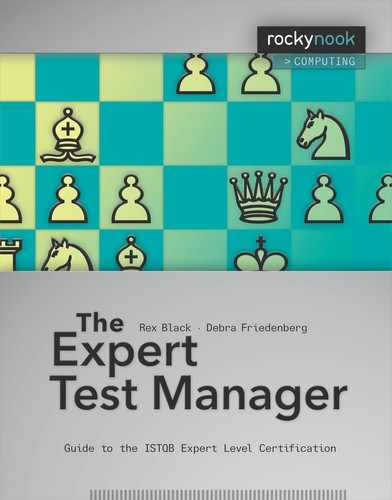Contents
Leo van der Aalst’s Acknowledgements
James L. Rommens’ Acknowledgements
1Test Missions, Policies, Strategies, and Goals
1.2Mission, Policy, and Metrics of Success
1.2.1 Identifying Stakeholders
1.2.2 Understanding the Mission and Objectives
1.2.4 Setting and Meeting Goals
1.3.1 The Contents of the Test Strategy
1.3.5 Process- or Standard-Compliant Strategies
1.3.8 Regression-Averse and Test Automation Strategies
1.3.9 Developing a Workable Test Strategy
1.4Alignment of Test Policy and Test Strategy with the Organization
1.4.1 Practical, Complete, and Consistent Test Policies and Strategies
1.4.2 Successful Test Policies and Test Strategies
2.2.4 Selecting the People to Hire
2.2.5 Bringing People Into the Team
2.2.6 Termination of Employment
2.2.7 Ending Contractual Relationships
2.3.2 Setting Goals and Objectives
2.3.3 Defining Clear Roles and Responsibilities
2.3.4 Individual Personalities and Roles Within Teams
2.3.5 Skills Development, Training Opportunities, and Mentoring
2.3.6 Performance Reviews and Feedback
2.4.1 Information Sharing and Communication
2.4.2 Fostering Loyalty and Trust
2.4.4 Motivating and Challenging the Test Team
2.4.5 Managing Distributed Teams
3Managing External Relationships
3.2Types of External Relationships
3.4.1 Dimensions of Information Strategies
3.4.3 Other Communication Considerations
3.5Integrating from External Sources
4Managing Across the Organization
4.2Types of External Relationships
4.2.1 Promoting and Advocating the Test Organization
4.2.2 Selling the Value of Testing
4.2.3 Creating a Defensible Team
4.2.4 Protecting and Supporting the Team
4.3.1 Independence and Reporting Structure
4.5Creating and Building Relationships
4.6Advocating Quality Activities Across the Organization
4.7Integrating Tools Across the Organization
4.7.1 Purchasing, Selecting, and Acquiring the Multiuse Tool
4.7.2 Updating, Maintaining, and Supporting the Multiuse Tool
4.7.3 Converting and Retiring Tools
4.7.4 The Manager Role with Multiuse Tools
4.8.1 Managing the Team’s Ethics
4.8.2 Interacting with Test Stakeholders and Reporting Test Results
5Project Management Essentials
5.2.2 Defining the Testing Schedule
5.2.3 Budgeting and Resource Allocation
5.2.4 Managing and Tracking a Project
5.3.2 Participating in Project-wide Risk Management
5.4Quality Management and Testing
6Test Project Evaluation and Reporting
6.3Evaluating and Using Information — Internal Reporting
6.4Sharing Information — External Reporting
6.5Test Results Reporting and Interpretation
6.6Statistical Quality Control Techniques
7Testing Considerations for Domain and Project Factors
7.2Test Management Considerations for Lifecycle Models
7.2.1 Comparison of Lifecycle Models
7.2.2 Waterfall and Agile Models
7.2.3 Testing Concepts in Agile Approaches
7.2.4 Changed Role of Test Manager in Agile Approaches
7.3Managing Partial Lifecycle Projects
7.3.3 Hardware/Software and Embedded Systems Projects
7.3.4 Safety-critical Systems Projects
7.4Release Advice and Considerations
8Evaluating Effectiveness and Efficiency
8.2Effectiveness, Efficiency, and Satisfaction Metrics for the Test Process
8.3Effectiveness, Efficiency, and Satisfaction Metrics for the Test Policy Objectives
Appendix A: The Expert Test Manager Exams
Appendix B: Answers and Explanations for Chapter Sample Questions
